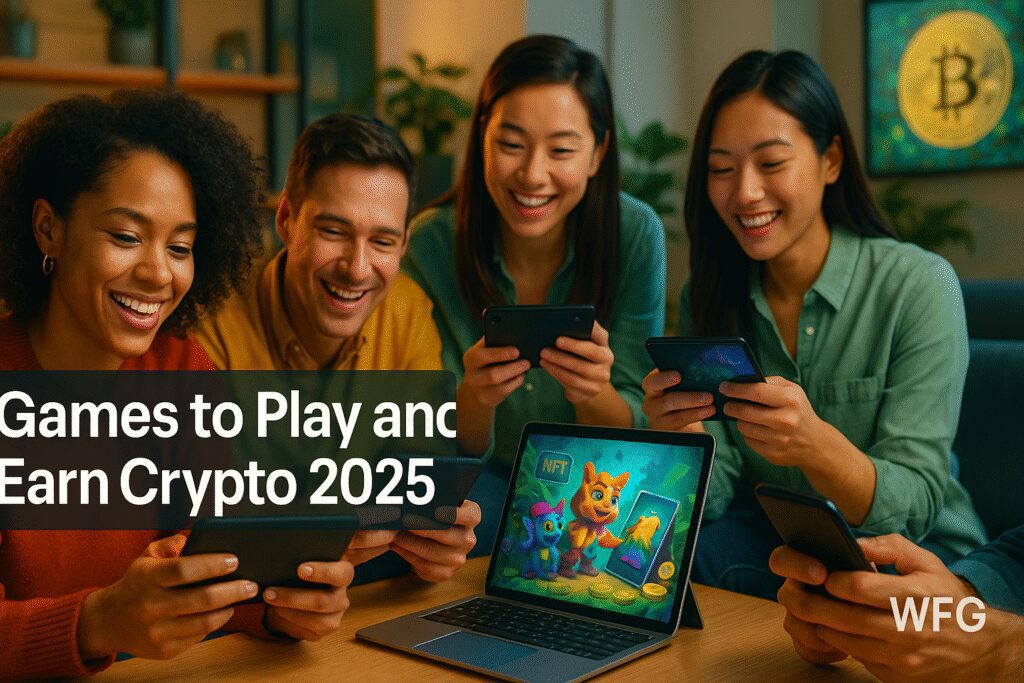Games to play and earn crypto have transformed from experimental blockchain projects into sophisticated ecosystems where NFT collectors can leverage their digital assets for substantial returns. The landscape has evolved dramatically, with gaming platforms now offering unprecedented opportunities for collectors to maximize both their entertainment value and investment potential through strategic gameplay and asset management.
The fusion of NFT collecting and crypto gaming represents more than just a trend—it’s a fundamental shift in how digital ownership creates value. For collectors who’ve built substantial NFT portfolios, these gaming platforms offer a chance to put dormant assets to work while potentially discovering new revenue streams that traditional collecting simply cannot match.
Why NFT Collectors Are Dominating Crypto Gaming
The convergence of NFT collecting and play-to-earn gaming has created a perfect storm of opportunity. Experienced collectors already understand digital asset valuation, market dynamics, and the importance of community-driven projects—skills that translate directly into gaming success. This knowledge gives NFT collectors a significant advantage over traditional gamers entering the crypto gaming space.
NFT collectors possess something invaluable in crypto gaming: patience and strategic thinking. While newcomers often chase quick profits, seasoned collectors understand that the most valuable gaming assets often require time to appreciate. They recognize quality artwork, strong tokenomics, and sustainable project roadmaps—exactly the factors that determine long-term success in crypto gaming.
Your existing NFT portfolio might already unlock gaming advantages you haven’t explored. Many gaming platforms offer special benefits, exclusive access, or enhanced earning potential for holders of specific NFT collections. This cross-platform utility is expanding rapidly, making your current collection potentially more valuable than you realize.
Top Crypto Games That Maximize NFT Value
Axie Infinity – The Pioneer of NFT Gaming Ecosystems

Axie Infinity remains the gold standard for games to play and earn crypto, particularly for NFT collectors who understand the nuances of creature-based assets. Each Axie functions as a unique NFT with distinct genetic traits that influence both battle performance and breeding potential, creating a complex economy that rewards deep understanding of genetic combinations.
Best Rated Online Gambling Sites in 2025: Play Safe, Win Big
The platform’s dual-token system—AXS for governance and SLP for daily earnings—offers multiple revenue streams. Skilled players can earn 150-300 SLP daily, while strategic breeders focus on creating rare genetic combinations that sell for premium prices. The scholarship system allows collectors with multiple Axies to rent them out, generating passive income while helping new players enter the ecosystem.
Recent updates have introduced land gameplay and expanded the Axie universe, creating new utility for existing NFT holders. Land owners can host other players, charge fees, and earn from resource generation, adding another layer of earning potential for committed collectors.
The Sandbox – Virtual Real Estate Meets NFT Collections
The Sandbox transforms games to play and earn crypto by combining virtual real estate with comprehensive NFT integration. LAND owners can monetize their plots through various methods: hosting events, renting space to other creators, or developing games that attract visitors and generate revenue through the platform’s SAND token economy.
What sets The Sandbox apart for NFT collectors is its partnership ecosystem. Owning NFTs from partner collections often grants special access to exclusive areas, limited-time events, or unique avatar customization options. These partnerships create ongoing value for collectors who might otherwise view their NFTs as static assets.
The platform’s creator economy allows technically minded collectors to build experiences on their LAND, potentially generating substantial ongoing revenue. Some land owners report monthly earnings equivalent to several thousand dollars through successful game creation and hosting premium events.
Gods Unchained – Trading Card Game Revolution
Gods Unchained appeals specifically to NFT collectors who appreciate the trading card game format. Each card exists as an NFT, allowing players to trade freely on secondary markets while earning through competitive play. The game’s “Play to Earn” model rewards skilled players with card packs and GODS tokens, creating multiple earning opportunities.
The platform’s unique “Forge” system allows players to upgrade cards by combining multiple copies, creating stronger NFT versions that command higher market prices. This mechanism rewards both gameplay skill and strategic card collection, making it ideal for collectors who enjoy optimizing their holdings.
Weekend tournaments offer substantial prize pools, with top players earning hundreds of dollars worth of cards and tokens. The combination of skill-based earning and asset appreciation makes Gods Unchained particularly attractive for collectors who want active engagement with their NFT investments.
Illuvium – AAA Gaming Experience with Premium NFTs
Illuvium represents the next evolution of games to play and earn crypto, offering console-quality graphics with sophisticated NFT integration. Each Illuvial (creature) exists as a unique NFT with distinct abilities, making collection strategy crucial for competitive success.
The game’s three-token ecosystem—ILV for governance, sILV for in-game purchases, and Fuel for transactions—creates multiple earning opportunities. Players can capture and train Illuvials, then sell them on secondary markets where rare variants command premium prices.
What makes Illuvium exceptional for NFT collectors is its focus on asset quality and long-term value. The development team emphasizes creating NFTs that retain value through both gameplay utility and artistic merit, addressing a common concern among collectors about purely speculative gaming assets.
Evaluating Earning Potential: ROI Analysis for NFT Gaming
Daily Earning Mechanisms Across Popular Platforms
Understanding daily earning potential is crucial for NFT collectors evaluating games to play and earn crypto. Axie Infinity offers the most predictable daily earnings, with committed players earning 150-300 SLP daily, translating to $15-45 depending on token prices. However, this requires initial investment in three Axies, typically costing $300-600.
The Sandbox provides less predictable but potentially higher earnings through land monetization. Successful land owners report monthly earnings ranging from $500 to $5,000, but success depends heavily on location, development quality, and marketing skills. Initial investment requirements are substantially higher, with quality LAND parcels costing $2,000-10,000.
Gods Unchained offers earnings through both tournament prizes and card trading. Skilled players can earn $50-200 weekly through tournament participation, while successful traders profit from card market fluctuations. The barrier to entry is lower, with competitive decks buildable for $100-300.
Long-term Value Appreciation of Gaming NFTs
Gaming NFTs demonstrate different appreciation patterns compared to traditional NFT collections. Utility-driven assets like Axies or Illuvials tend to maintain value better during market downturns because they generate ongoing income regardless of secondary market conditions.
Historical data shows that gaming NFTs with strong utility and active player bases maintain 60-80% of their peak values during bear markets, compared to 20-40% for purely speculative NFT collections. This resilience makes gaming NFTs attractive for collectors seeking more stable investments.
The key factor driving long-term appreciation is sustainable tokenomics. Projects with deflationary token mechanisms, like burning tokens for upgrades or breeding, tend to maintain healthier long-term price action compared to purely inflationary reward systems.
Market Liquidity and Trading Volume Considerations
Liquidity analysis reveals significant differences across gaming platforms. Axie Infinity maintains the highest trading volumes, with daily marketplace transactions exceeding $1 million during peak periods. This high liquidity ensures collectors can exit positions quickly when needed.
The Sandbox LAND market shows more volatile trading patterns, with significant price movements during major announcements or partnership reveals. While this creates profit opportunities, it also increases risk for collectors requiring predictable exit liquidity.
Gods Unchained card markets demonstrate seasonal patterns tied to tournament schedules and meta changes. Understanding these cycles allows savvy collectors to time purchases and sales for optimal returns.
Cross-Game NFT Utility and Interoperability
The future of games to play and earn crypto lies in cross-platform NFT utility. Several projects are developing standards that allow NFTs to function across multiple gaming environments, potentially multiplying the value of existing collections.
Immutable X, the layer-2 solution powering Gods Unchained, is expanding to support multiple games, allowing NFTs to transfer between platforms. This interoperability could transform static NFT collections into dynamic gaming assets that generate value across multiple games simultaneously.
Early adopters of cross-platform NFT collections position themselves for significant advantages as this technology matures. Collecting NFTs from projects with confirmed multi-game partnerships could yield substantial returns as utility expands beyond single-game limitations.
Building a Strategic Crypto Gaming Portfolio
Balancing High-Risk, High-Reward Gaming Tokens
Successful crypto gaming portfolios balance stable, utility-driven assets with higher-risk, higher-reward opportunities. Allocating 60-70% to established platforms like Axie Infinity or The Sandbox provides stable earning potential, while reserving 30-40% for emerging projects offers explosive growth potential.
New gaming projects often offer early adopter advantages, including discounted NFT prices, exclusive access, or enhanced earning rates. However, these opportunities carry significant risk, as many new projects fail to achieve sustainable player bases or token economies.
Diversification across different gaming genres—strategy games, virtual worlds, trading card games—reduces portfolio risk while capturing opportunities in multiple market segments.
Diversification Strategies for Gaming NFT Assets
Geographic and platform diversification protects against regulatory risks and technical failures. Spreading investments across Ethereum-based games, Polygon projects, and emerging blockchain ecosystems like Solana or Avalanche reduces concentration risk.
Asset type diversification within gaming portfolios should include income-generating assets (like breeding Axies), appreciating assets (like rare land parcels), and liquid trading assets (like Gods Unchained cards) to balance growth, income, and liquidity needs.
Exit Strategy Planning for Gaming Investments
Planning exit strategies before entering gaming investments protects against emotional decision-making during volatile periods. Establishing clear profit-taking levels—such as selling 25% of holdings after 2x returns—locks in gains while maintaining upside exposure.
Consider the tax implications of different exit strategies, as frequent trading may trigger short-term capital gains taxation, while holding gaming NFTs for over a year qualifies for more favorable long-term treatment in many jurisdictions.
Getting Started: Setting Up Your Gaming Wallet and Accounts
Technical preparation is crucial for success in games to play and earn crypto. Most platforms require MetaMask or similar Web3 wallets configured for specific blockchain networks. Ensure your wallet supports the networks used by your chosen games—Ethereum for Axie Infinity and The Sandbox, Immutable X for Gods Unchained.
Best NFT Games to Earn Money in 2025: A Complete Guide for Gamers and Crypto Enthusiasts
Security best practices become even more critical in gaming contexts, where daily transactions increase exposure to potential threats. Use hardware wallets for storing valuable NFTs, while maintaining separate “hot” wallets for daily gaming activities with limited funds.
Create accounts on relevant marketplaces like OpenSea, Immutable X Marketplace, and Axie Marketplace before beginning gameplay. Understanding these platforms’ fee structures and trading mechanisms helps optimize your earning potential and reduces costly mistakes.
FAQ: Common Questions About NFT Gaming
What’s the minimum investment needed to start earning in crypto games?
The minimum investment varies significantly across platforms. Gods Unchained allows free-to-play entry with earning potential, while Axie Infinity requires $300-600 for a starter team. The Sandbox land ownership typically requires $2,000+ investment, though players can earn by playing others’ games without owning land.
How much can NFT collectors realistically earn monthly from crypto gaming?
Earnings depend heavily on time investment, skill level, and initial capital. Casual players might earn $50-200 monthly, while dedicated players with substantial initial investments can earn $500-2,000+ monthly. Top-tier players and successful land developers earn significantly more, but these results require exceptional skill and substantial time commitment.
Are crypto gaming earnings sustainable long-term?
Sustainability depends on player adoption, tokenomics design, and continued development. Established games with strong communities and deflationary token mechanisms show the best sustainability prospects. However, all crypto gaming investments carry significant risk, and earnings can fluctuate dramatically with market conditions.
How do I evaluate new crypto gaming projects before investing?
Focus on team experience, tokenomics sustainability, partnership strength, and community engagement. Avoid projects with purely inflationary token models or unrealistic earning promises. Look for games with genuine entertainment value beyond earning potential, as these tend to maintain stronger long-term player bases.




Pingback: play games online without ads
Pingback: Hollywood Casino Online Slots Real Money: Complete Bonus Guide 2025 - Wow-Free-Games